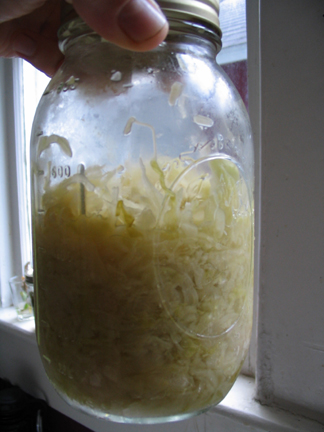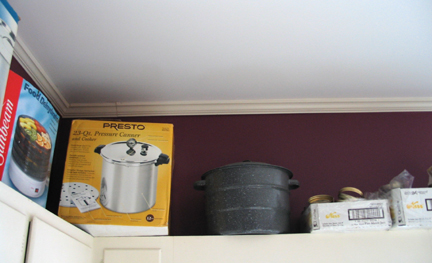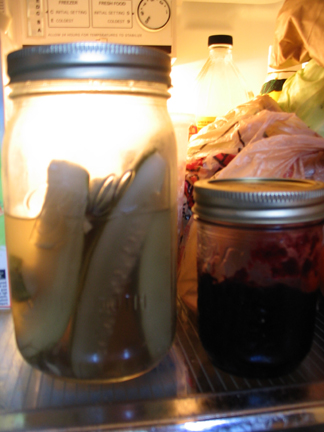Making sauerkraut
Fermentation is something that I only recently began to appreciate and learn about. Since picking up the books Wild Fermentation and Preserving Food Without Freezing or Canning, I have been taking on fermentation projects a few times a week. The kitchen is littered with quart mason jars full of various colors and smells, the fridge is home to some finished products and ongoing ferments (like sourdough starter) and our small basement holds a crock of developing sauerkraut.
If you have never had sauerkraut, I’ll ask you to consider giving it a try. The tangy, salty goodness is perfect on a tomato sandwich, on a salad instead of salad dressing or simply by itself. I have eaten the store bought variety from Bubbies right out of the jar, but it wasn’t until I pulled out a jar full of the stuff that I made that I truly appreciated the taste and amazed myself by how much of it I could eat. And eating it raw (unpasteurized) maintains the beneficial aspects of lacto-fermentation such as good bacteria, high quantities of vitamin C and keeping certain acids available to aid in digestion.
I started the process with a few heads of green cabbage from Black River Organic Farm (45 miles), a cabbage cutter, some salt and a Harsch fermenting crock.
1 – Weigh out the cabbage, either at the store when you buy it or at home if you have a scale. For every five pounds of cabbage you will need three tablespoons of salt.
2 – Measure out the salt you will need and place it in a bowl.
3 – Halve the cabbages and shred using a knife, a grater or whatever you have available.
I used a heavy duty cabbage grater and it made the process go very quickly.
4 – As you grate the cabbage, add it to the crock. As you add a layer, sprinkle the cabbage with salt. The salt will pull water out of the cabbage.
5 – Continue layering the cabbage and salt, pressing down occasionally with your fist or a utensil to press water out of the cabbage. Don’t fill the crock all the way to the top. I filled about 3/4 of the way up and compressed the cabbage further down.
6 – Once you have all the cabbage and salt in the crock, you will need to get enough brine generated to cover the cabbage and the weight (a plate or the stones that come with a Harsch crock) needed to hold the cabbage under the level of the brine. You can use whatever you have handy to do the pressing. I just beat the cabbage with my fist until I had plenty of brine and the cabbage was tight and compressed in the crock.
7 – Place a whole cabbage leaf over the contents to keep any bits of cabbage from floating in the brine.
8 – Add a weight to the top of the cabbage such as a plate or, if using a Harsch crock, add the two stones. Make sure that the brine covers the weight. If you need more brine, add salt water in a ratio of 1 tablespoon salt to 1 cup of water.
9 – If using an open crock, cover it with a towel secured by rubber bands. This is to keep dust and creatures out. If using a Harsch crock, put the cover down in the groove and fill the groove with water. Be sure to check on the crock periodically to refill the water.
10 – With a Harsch crock there is no daily maintenance required, only minimal inspection to check on the water in the groove. With an open crock you will need to scoop out any film or mold that forms on the surface. If mold forms be sure to wash the plate. Also be sure to check the brine level in an open crock and add salt water if needed.
11 – In an open crock in warm weather you can start removing sauerkraut after a week or so. With a Harsch crock leave it to ferment for about 4 weeks then take a sample. Mine was good and tangy after 4 weeks. You can scoop everything out at once or just take a bit at a time. The sauerkraut will get better as it continues to ferment. I put my crock away after filling a quart jar with the contents. I’ll take out some more next week and the week after.

This process is based on the recipe in Wild Fermentation with some tips from my experience and some additional instructions for using the Harsch crock.




you know, that is one thing I have never made..sounds like I should…we could call it science!
Great write up! I love sauerkraut and started making it 2 years ago. The thing I love best about it aside from the taste, is that you don’t have to can it, as you mentioned. I’ll be doing salted green beans this week in basically the same way. These taste fabulous and also don’t need canning. I will look into the books you mentioned, they sound interesting!
home-made sauerkraut.. fond memories of the salad made by the mennonite/amish in lancaster county, pa. it had diced green pepper, diced apples, raisins, and i think a tad of chopped onion. heavenly stuff. those were the days of the ‘big kitchen’.. putting up local and garden goodies for the full year. fermenting pickles, green tomatoes, hot red peppers doing their strange ferment in jars lined up on the counter.. so pretty and so tasty! fermenting is a wonderful “lost” food-art.
This sauerkraut keeps getting better and better. I have been putting it on everything!
The whole Harsch crock makes this process sound much easier. I first read about home-made sauerkraut in The 100 Mile Diet and the process of skimming mold from the top really grossed me out. However, I think I’d try it your way without the open crock.
The Harsch crock is a great investment in food preservation. Get the biggest one you can afford.
I was taught how to make kraut by my German mother and have teaching a class on macrofermentation for a number of years. The Harsch crock is the best and easiest way to effortlessly ferment kraut, or as I did last summer, a crock full of pickled veggies. It’s a fantastic device well worth the price.
The Harsch crock is an awesome way to get started with fermentation and to keep at it.
Would it be possible to send me the instructions I lost to my harsch crock via e-mail?
Just loaded up my Harsch 10L crock last night with my first batch of kraut! I used two heads of green cabbage, one head of Napa Cabbage, and two fresh green tomatoes from my garden (got a wild hair with the tomatoes but can’t wait to try it now!) I’m excited about my first batch and can’t wait to sample it.